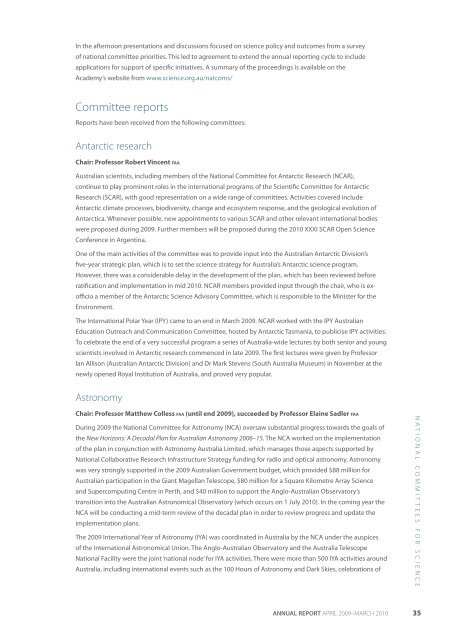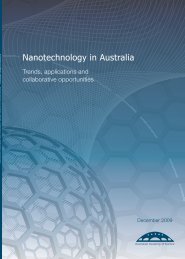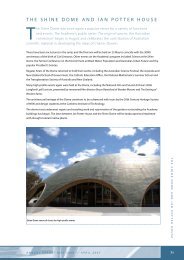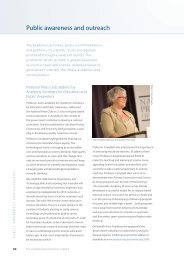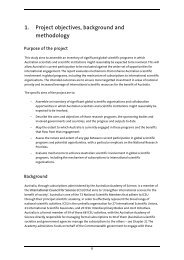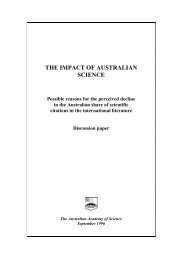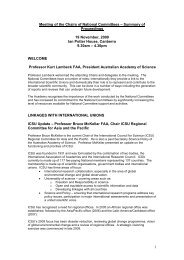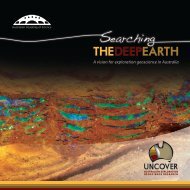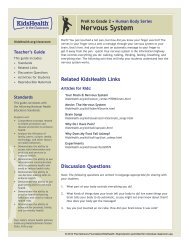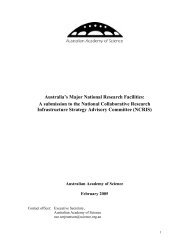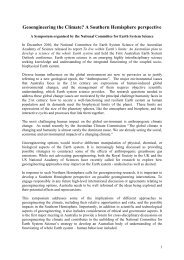ANNUAL REPORT - Australian Academy of Science
ANNUAL REPORT - Australian Academy of Science
ANNUAL REPORT - Australian Academy of Science
Create successful ePaper yourself
Turn your PDF publications into a flip-book with our unique Google optimized e-Paper software.
In the afternoon presentations and discussions focused on science policy and outcomes from a survey<br />
<strong>of</strong> national committee priorities. This led to agreement to extend the annual reporting cycle to include<br />
applications for support <strong>of</strong> specific initiatives. A summary <strong>of</strong> the proceedings is available on the<br />
<strong>Academy</strong>’s website from www.science.org.au/natcoms/<br />
Committee reports<br />
Reports have been received from the following committees:<br />
Antarctic research<br />
Chair: Pr<strong>of</strong>essor Robert Vincent FAA<br />
<strong>Australian</strong> scientists, including members <strong>of</strong> the National Committee for Antarctic Research (NCAR),<br />
continue to play prominent roles in the international programs <strong>of</strong> the Scientific Committee for Antarctic<br />
Research (SCAR), with good representation on a wide range <strong>of</strong> committees. Activities covered include<br />
Antarctic climate processes, biodiversity, change and ecosystem response, and the geological evolution <strong>of</strong><br />
Antarctica. Whenever possible, new appointments to various SCAR and other relevant international bodies<br />
were proposed during 2009. Further members will be proposed during the 2010 XXXI SCAR Open <strong>Science</strong><br />
Conference in Argentina.<br />
One <strong>of</strong> the main activities <strong>of</strong> the committee was to provide input into the <strong>Australian</strong> Antarctic Division’s<br />
five-year strategic plan, which is to set the science strategy for Australia’s Antarctic science program.<br />
However, there was a considerable delay in the development <strong>of</strong> the plan, which has been reviewed before<br />
ratification and implementation in mid 2010. NCAR members provided input through the chair, who is ex<strong>of</strong>ficio<br />
a member <strong>of</strong> the Antarctic <strong>Science</strong> Advisory Committee, which is responsible to the Minister for the<br />
Environment.<br />
The International Polar Year (IPY) came to an end in March 2009. NCAR worked with the IPY <strong>Australian</strong><br />
Education Outreach and Communication Committee, hosted by Antarctic Tasmania, to publicise IPY activities.<br />
To celebrate the end <strong>of</strong> a very successful program a series <strong>of</strong> Australia-wide lectures by both senior and young<br />
scientists involved in Antarctic research commenced in late 2009. The first lectures were given by Pr<strong>of</strong>essor<br />
Ian Allison (<strong>Australian</strong> Antarctic Division) and Dr Mark Stevens (South Australia Museum) in November at the<br />
newly opened Royal Institution <strong>of</strong> Australia, and proved very popular.<br />
Astronomy<br />
Chair: Pr<strong>of</strong>essor Matthew Colless FAA (until end 2009), succeeded by Pr<strong>of</strong>essor Elaine Sadler FAA<br />
During 2009 the National Committee for Astronomy (NCA) oversaw substantial progress towards the goals <strong>of</strong><br />
the New Horizons: A Decadal Plan for <strong>Australian</strong> Astronomy 2006–15. The NCA worked on the implementation<br />
<strong>of</strong> the plan in conjunction with Astronomy Australia Limited, which manages those aspects supported by<br />
National Collaborative Research Infrastructure Strategy funding for radio and optical astronomy. Astronomy<br />
was very strongly supported in the 2009 <strong>Australian</strong> Government budget, which provided $88 million for<br />
<strong>Australian</strong> participation in the Giant Magellan Telescope, $80 million for a Square Kilometre Array <strong>Science</strong><br />
and Supercomputing Centre in Perth, and $40 million to support the Anglo-<strong>Australian</strong> Observatory’s<br />
transition into the <strong>Australian</strong> Astronomical Observatory (which occurs on 1 July 2010). In the coming year the<br />
NCA will be conducting a mid-term review <strong>of</strong> the decadal plan in order to review progress and update the<br />
implementation plans.<br />
The 2009 International Year <strong>of</strong> Astronomy (IYA) was coordinated in Australia by the NCA under the auspices<br />
<strong>of</strong> the International Astronomical Union. The Anglo-<strong>Australian</strong> Observatory and the Australia Telescope<br />
National Facility were the joint ‘national node’ for IYA activities. There were more than 500 IYA activities around<br />
Australia, including international events such as the 100 Hours <strong>of</strong> Astronomy and Dark Skies, celebrations <strong>of</strong><br />
NATIONAL COMMITTEES FOR SCIENCE<br />
<strong>ANNUAL</strong> <strong>REPORT</strong> APRIL 2009–MARCH 2010 35


